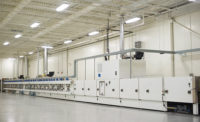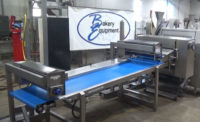Heat Management for Bakery Ovens, Part 1

There are any number of ways to look at a bakery oven and its performance; however, for the most part all of the elements impact the essential heat conditions from input to output for the baker’s oven. What’s important, and how the elements come together, is in heat management.
The following article discusses heat management in direct fired gas tunnel and tray ovens with two pipe (separate air and gas headers) combustion systems with direct spark (DSI) ignition/flame monitoring. The ovens have multiple zones, with each zone having multiple ribbon gas burners. All burners are equipped with an igniter, a solenoid shut-off gas valve(s), an adjustable gas orifice cock and a proportional air/gas mixer. The zones have a dedicated temperature controller and a modulating butterfly valve to control the combustion air supply to the zone air header. A zero governor or regulator maintains a supply of gas to the zone gas header at “zero” psig.
Controlling Heat
Controlling heat and temperature in these bakery ovens (zones), where a consistent temperature is needed to manage the heat, requires a mixture of fuel and pressurized combustion air be supplied to the burners. The quantity of air/fuel mixture supplied to the burners is governed by the combustion air pressure provided to the burners. The combustion air pressure is adjusted in response to the temperature variations in the zone, in order to maintain the needed temperature and heat demand of the zone. The zone combustion air pressure also may be monitored and used in a way to adjust the number of ignited burners in each zone. Temperature and heat in the direct fired oven are ultimately managed by controlling fuel and air flow from the external sources to each of the burners.
The amount of air/fuel mixture (10 parts air to 1 part natural gas) delivered to the burners is based on accurate temperature sensing within the zone. As the zone temperature deviates from the temperature control setpoint, the quantity of the mixed air/fuel delivered to the burners is adjusted by increasing or decreasing the zone pressure of the combustion air. Stated another way, thermal response depends on adjusting the pressure of combustion air delivered to the burners which react inversely to the sensed temperature change. Therefore, a reduction in zone combustion air pressure reduces the quantity of fuel supplied to the burners, lowering the heat input to the zone, and an increase in combustion air pressure increases the quantity of fuel supplied to the burners and raises the heat input to the zone.
Click to Read the Complete Article
Looking for a reprint of this article?
From high-res PDFs to custom plaques, order your copy today!





